City Council's Top 5 Concerns About the Brooklyn Heights Library Sale and Development
Could the sale of the Brooklyn Heights public library to a private developer result in condos but no library? Is the site’s $52,000,000 price tag fleecing the public? Is offsite affordable housing segregationist? Those are just a few of the cutting questions that emerged at a full-capacity City Council subcommittee hearing Wednesdayto get the facts on the controversial sale of the current Brooklyn…

Could the sale of the Brooklyn Heights public library to a private developer result in condos but no library? Is the site’s $52,000,000 price tag fleecing the public? Is offsite affordable housing segregationist?
Those are just a few of the cutting questions that emerged at a full-capacity City Council subcommittee hearing Wednesdayto get the facts on the controversial sale of the current Brooklyn Heights library site to private developer Hudson Companies.
“This is the most controversial issue I’ve seen in my district since my election in 2009,” said Council Member Steve Levin in his opening remarks. “Passions are running high. Here, we need to look at the objective facts.”
Brownstoner doesn’t often attend City Council meetings, but we had a feeling this debate would be gripping. We were right.
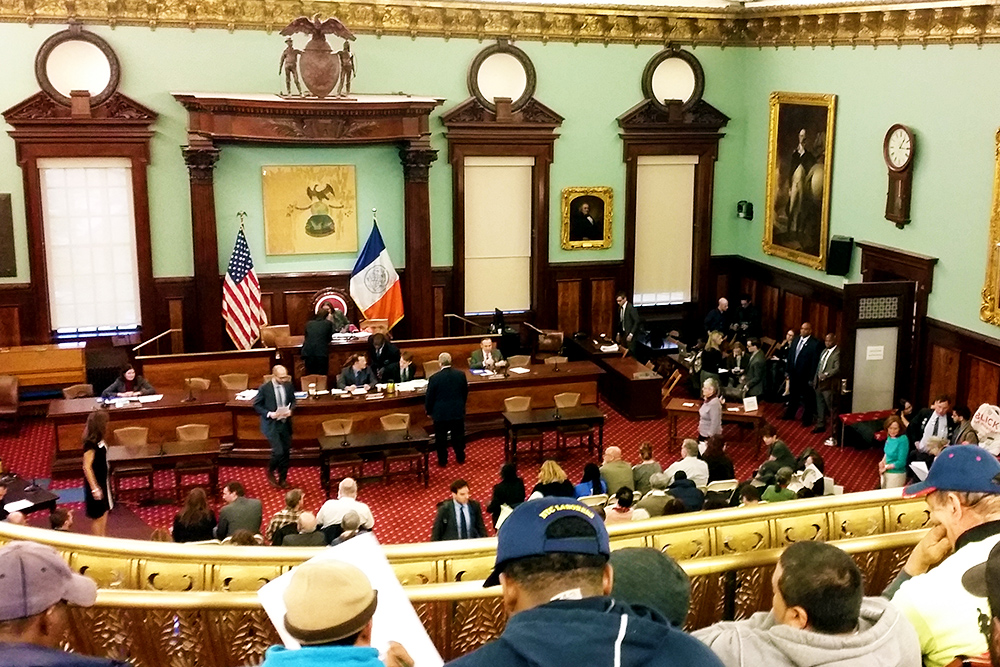
The hearing was in preparation for the official City Council vote on whether to approve the sale and development of the Heights library site, which must take place before the end of the year, but could be as early as Tuesday, November 24.
Despite some vocal community opposition, the proposal has already cleared several hurdles, passing Community Board 2 in July, only to be “disapproved” by Borough President Eric Adams in September, then unanimously approved by the City Planning Commission earlier this month.
The library plan entails selling the city-owned site at 280 Cadman Plaza West for $52,000,000 to Hudson, who will in turn build a 36-story condo tower with 139 luxury units, a new 25,500-square-foot library and two retail spaces on the ground floor. Hudson also committed to building 114 units of affordable housing at two sites in Clinton Hill — 1041-1047 Fulton Street and 911-917 Atlantic Avenue — in exchange for 145,000 extra square feet.

A few of the key players in yesterday’s meeting
Many supporters view the plan as a win-win for both the public and the developer — $40,000,000 from the sale will go to fix other run-down libraries. But the opposition sees the sale of the site as the irretrievable loss of valuable public property for a quick, unsustainable financial fix.
After a presentation by the core project team — Brooklyn Public Library President Linda Johnson, Hudson Companies Principal David Kramer, Architect Jonathan Marvel, and Jeff Nelson from the city’s Economic Development Coalition — Levin immediately kicked off the questions.
Over the next three hours, a number of consistent concerns emerged among the Council:
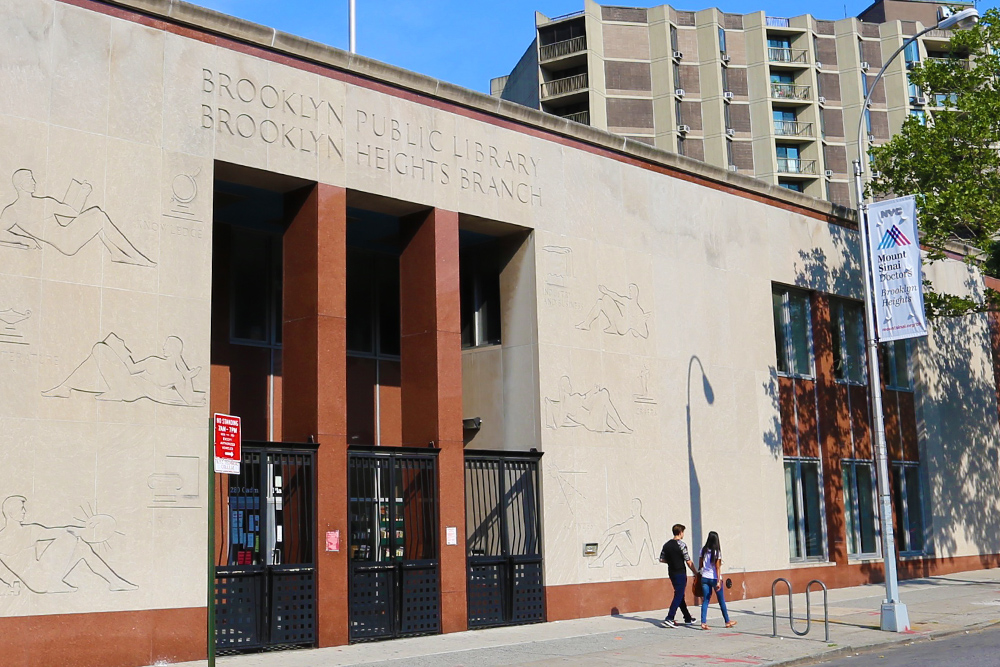
1. Is $52,000,000 a fair price?
Union coalition Build Up NYC issued a report Wednesday morning claiming that the $52,000,000 sale would fleece the public of up to 32 percent of the land’s actual value, between $68,000,000 and $78,000,000, the New York Daily News reported.
And rest assured, the City Council was very interested to discuss these findings.
Steve Levin, Brad Lander and others grilled the proposal team on the economic terms of the deal, how the land was valued, and how much money Hudson expected to make.
When David Kramer said that they anticipated getting $1,500 per square foot for the condos, Council Member Elizabeth Crowley called him out, saying that Kramer was already getting close to $2,000 per square foot at a development in Long Island City. “And I know that units in Brooklyn Heights sell for more than in Long Island City,” she said dryly.
Kramer countered, saying that there aren’t more than a handful of comparable units getting more than $2,000 per square foot in Brooklyn Heights. But Crowley was unconvinced. She believes the units will sell for upwards of $2,500 per square foot and that the sale price of the site should take that into account.
“You can’t blame people for asking these questions,” said Brand Lander. “Because the values for Downtown Brooklyn are obscene… values that have hit the stratosphere of obscene. That’s just what it is. That’s how real estate works. On the other hand, I’d ask you to respond to the Daily News article.”
“Look,” said Kramer. “The best way for the city to get a bang for the buck is to A) have a spirited, competitive bid, B) have an appraisal, and C) have a reappraisal before closing to make sure you have the checks and balances to make sure we’re not getting away with a lower than market bid. We stretched and really went so agressively to try and make this fit by going much higher than the city appraiser thought.”
Though there were other bids that offered more than $52,000,000 for the site, the project team continually said that Hudson’s proposal was the best all-around when considering the price, building, affordable units, and other aspects of the deal.
The bid of the other finalist in the process was within 2 percent of Hudson’s $52,000,000 bid.
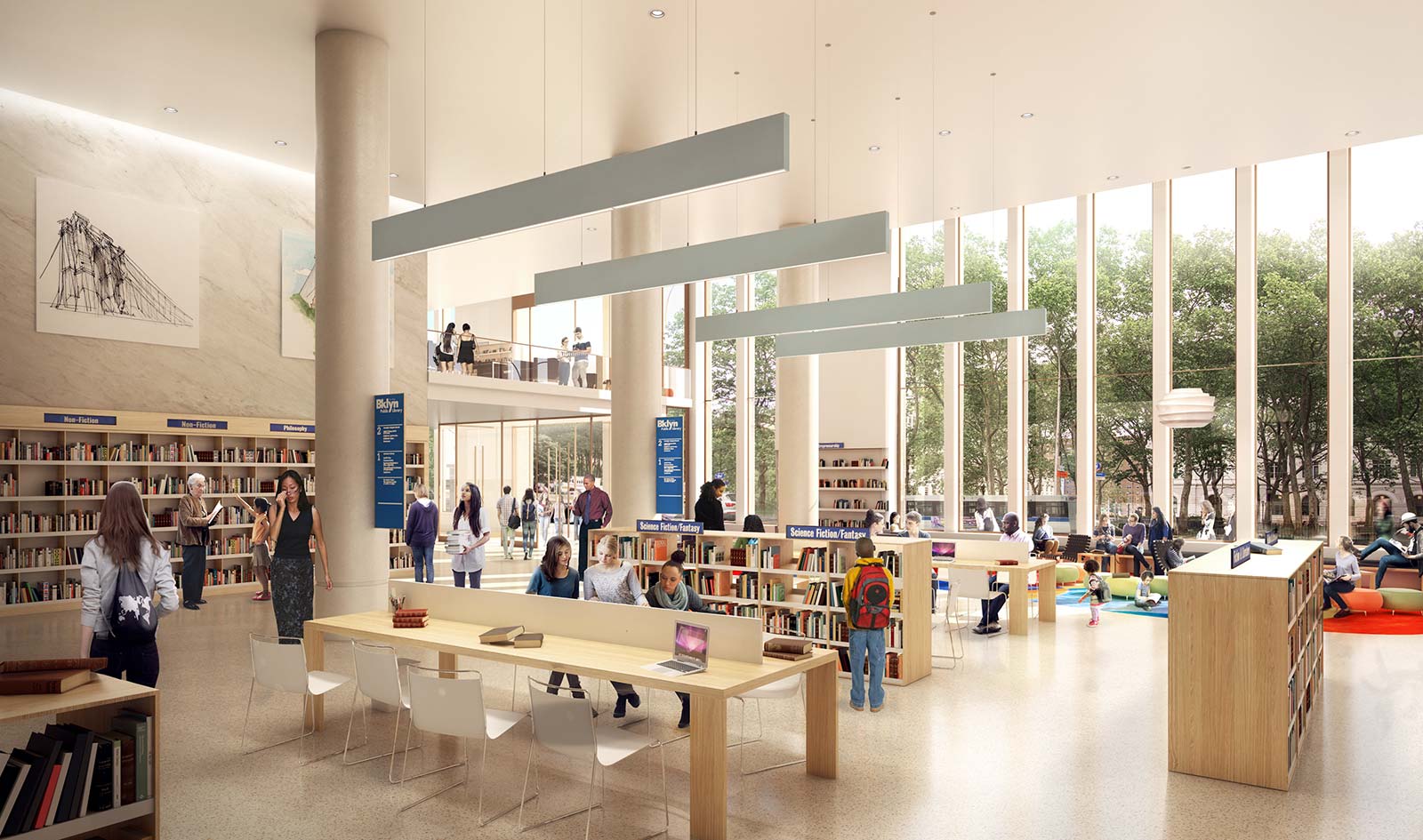
Rendering of the interior of the proposed new branch library at the base of the tower
2. Is the planned library big enough?
While the BPL’s Linda Johnson said multiple times that the new library would be larger than the current one, Council Member Steve Levin called her out for not counting the business library that’s also in the current space.
“When I walk into the library, I see one library. I don’t see two,” Levin said, also saying that the one item consistently called for by all parties was an even larger library space. The Council member even went so far as to challenge the planned community space on the lower floor — asking the developer and architect to explore expanding the library into the 18,000 square foot area that was originally slated as a $10,000,000 auditorium for St. Anne’s School — until the school pulled out.
Johnson countered saying that the more space they add, the more it will cost the library to outfit and maintain.
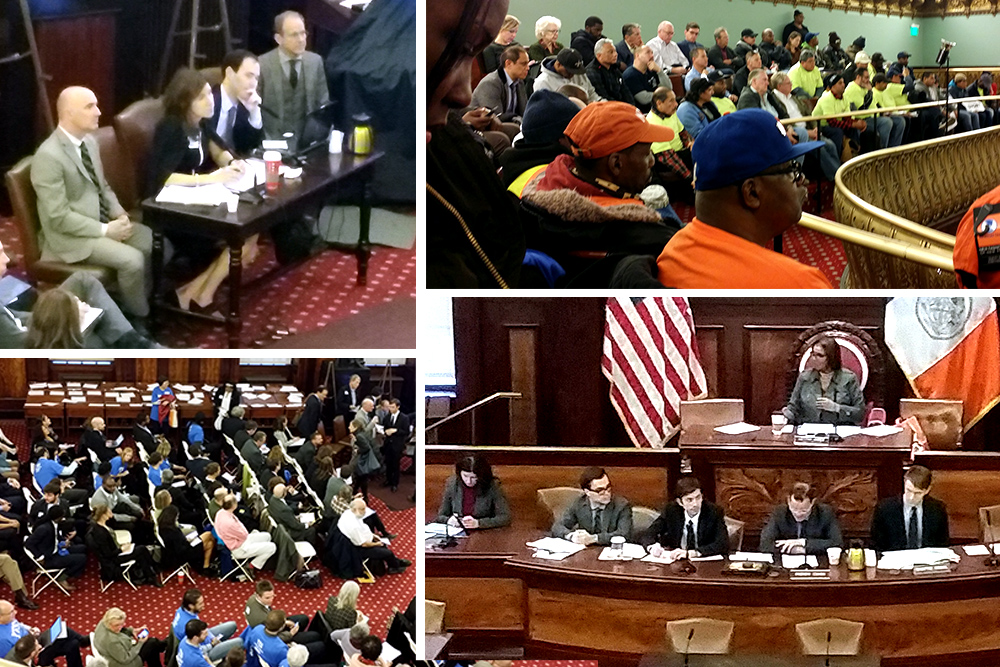
Clockwise from top left: the core team behind the proposal, predominantly pro-union attendees in the mezzanine, members of the City Council, blue-shirted library supporters in the main gallery.
3. Would the library get more money if there wasn’t affordable housing?
Land Use Committee Chair David Greenfield said that he calculated the affordable housing component was costing somewhere between $20,000,000 and $30,000,000. But that Hudson didn’t need to build 114 units in order to qualify for the extra square feet.
“You could have easily added more cash to the deal instead of building more non-required affordable housing,” said Greenfield.
“Ultimately, it comes back to where we were at the time Hudson was selected,” replied Jeff Nelson of the EDC. “We had comparable proposals in terms of the purchase price offer and Hudson took an extra step with delivering the additional affordable units and that’s what put them forward.”
For the record, Greenfield “remained skeptical.”
While $40,000,000 of the sale money is supposed to be put toward fixing other branch libraries, Borough President Eric Adams has called for an explicit guarantee that the money won’t be put in general city coffers, and that the BPL will create a more sustainable funding model to address its backlog of repairs, estimated at $300,000,000.
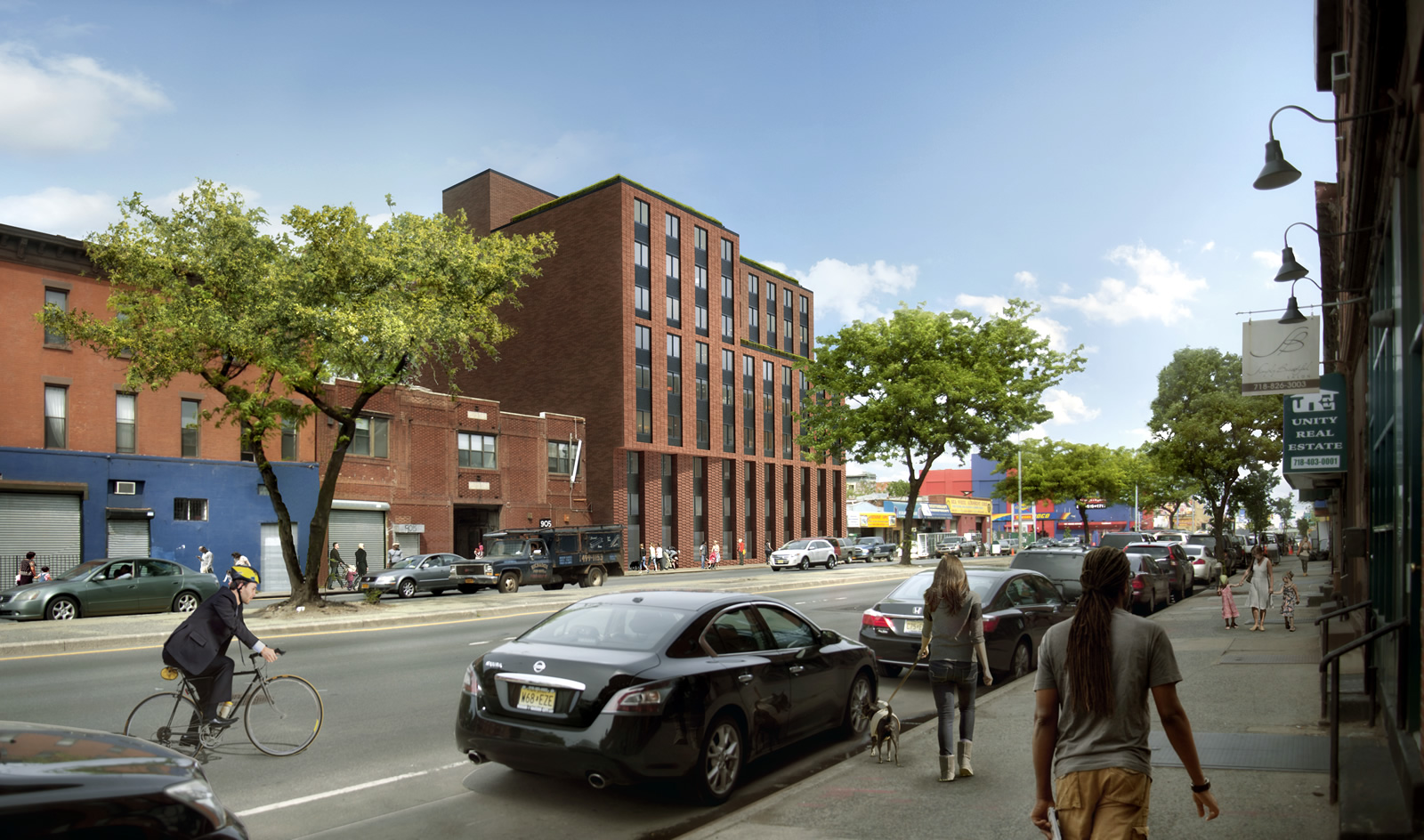
Rendering of the planned affordable building at 911-917 Atlantic Avenue
4. Is the affordable housing the right kind of affordable housing?
The Council Members took issue with the affordable housing component’s look, location, and AMI calculations.
“The design of these buildings is inferior to that of Brooklyn Heights,” intoned Public Advocate Letitia James. “This is primarily bricks and mortar and I think we can do better than that,” she continued, before silencing the boisterous outburst of cheers and applause following her comment.
James also cited the fact that most of the units in the buildings will be studios and one bedrooms, when some of the greatest need for housing in Brooklyn is for two and three bedrooms.
“I abhor all offsite affordable housing,” James said, likening it to government-sanctioned segregation. Council Member Elizabeth Crowley said that putting the affordable units in Clinton Hill was the same as building a “poor door.”
But the criticisms didn’t stop there. Steve Levin took issue with the “affordable” label itself, saying “For me, 165 percent of AMI is not affordable to your average New Yorker.”
New York’s Area Median Income (AMI) is $86,300 for a family of four. The affordable units are distributed with 23 apartments for those making 60 percent of AMI, 38 apartments for residents making 80 percent of AMI, 29 units at 100 percent AMI and Currently, and 24 apartments for those making 165 percent of AMI — $142,395 for a family of four.
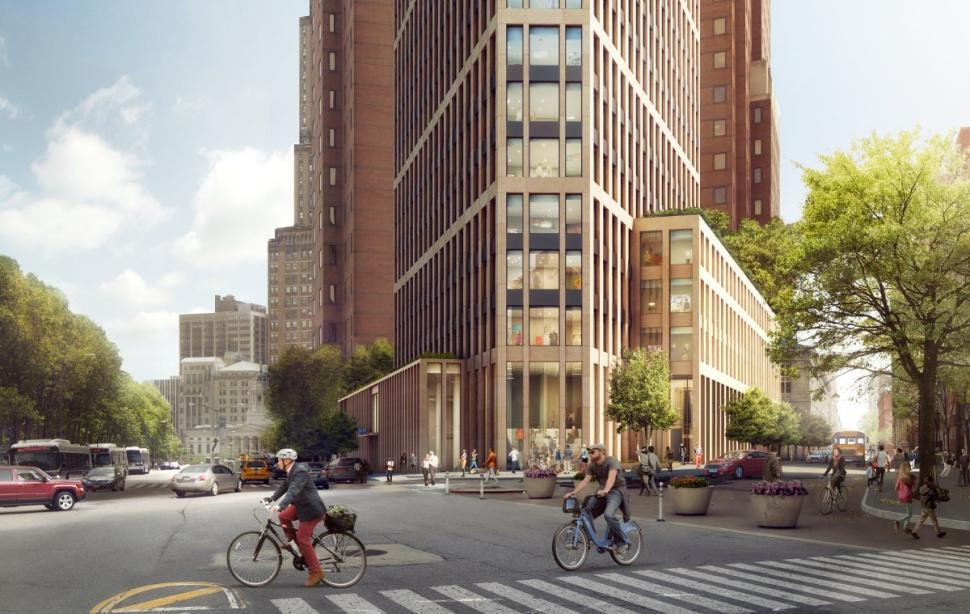
5. What’s to prevent a repeat of the Donnell Library fiasco?
Manhattan’s Donnell Library branch was similarly sold to a developer in exchange for cash and a new branch building. Seven years and one recession-racked developer later, there’s a gorgeous new hotel on the site but still no library branch.
“What happens if something goes wrong?” asked Council Member Levin. “One thing I heard about a lot for the past couple of years is what happened at the Donnell Library… what has the EDC, Brooklyn Public Library, developers learned from that?”
Linda Johnson replied that they’d learned three key things from the Donnell catastrophe: 1) to not shut down an operating branch until demolition is ready to begin, 2) to have a convenient interim library nearby, and 3) to include clauses in the deal giving the land back to the city if anything goes wrong.
Multiple times, developer David Kramer was asked about the details the arrangement. And in all cases — if Hudson doesn’t deliver, if Hudson goes bankrupt, if Hudson’s lenders want to cash out — the process would get completed another way or the property goes back to the city. And BPL gets to keep its $52,000,000.
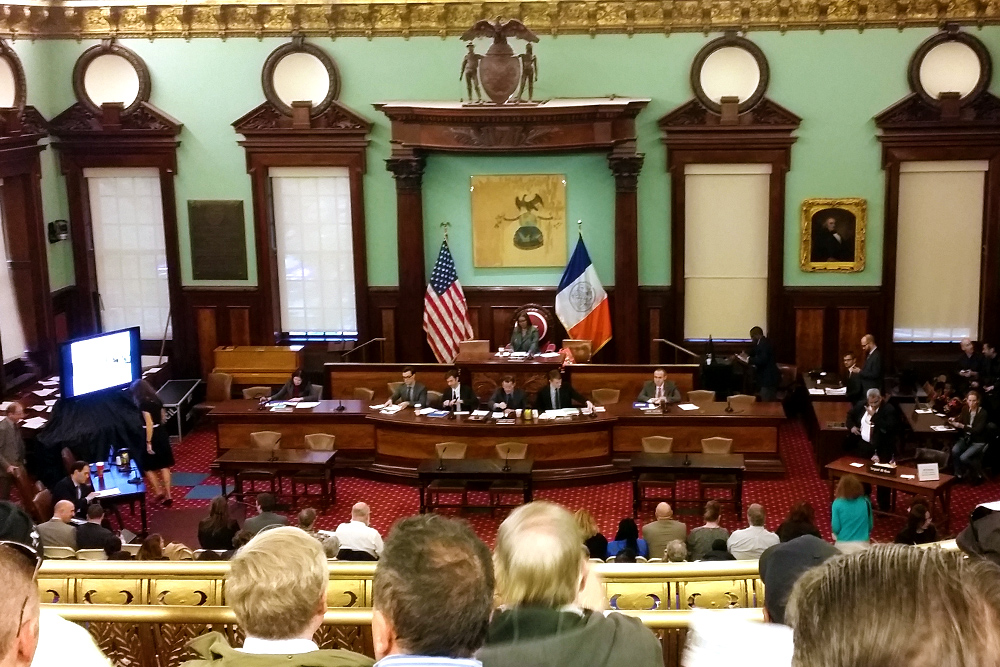
Wednesday’s City Council hearing is just a small step in the standard Uniform Land Use Review Procedure (ULURP) requiring multiple government and community bodies to approve the sale of a public asset like 280 Cadman. Soon, they’ll vote on the plan — to approve it, disapprove it, or approve it with conditions. At that time, Mayor Bill de Blasio will have five days to review — and possibly veto — the proposal.
[Renderings: Hudson Companies | Photos: Barbara Eldredge]
Related Stories
City Planning Unanimously Approves Brooklyn Heights Library Sale and Tower
Borough President Eric Adams “Disapproves” Controversial Plan to Develop Heights Library
Clinton Hill Affordable Housing From Brooklyn Heights Library Developer Revealed!









It is not coincidental that the bookshelves in the center of the artist’s rendering are marked “Science Fiction/Fantasy.” (No kidding, they really are.)
My specific problems with it are—overcrowding of PS, the shadow issue (read the documentation on that & consider its effect on neighborhood and the Korean War monument, which is pathetic enough as it is and will now be mostly in the dark), the offsite housing—about as far away in district as is possible, with lovely views of adjoining commercial/industrial areas (yeah, that’s fair).
Moreover, I hope that all of the public officials involved look at this in its full context: projected Pier Six and former LICH towers, the 1 BB Park building that has exceeded agreed upon plans & messing up views that tourists from around the world, no exaggeration, come and see. Now add this. It is death—overloading of infrastructure—by a thousand cuts. For the benefit of developers and wealthy people who aren’t even Brooklynites (at least I’ve been here two decades). The Mayor, having reneged on LICH, is playing along so he can add a few more “affordable” units to his total (gotta meet that campaign promise) no matter that they are in now way comparable to what the wealthy outsiders will get. Diversity will benefit the Heights.
Let me add, too, that the pushing of this by library and developer has been shameful. Unsolicited telephone campaign, misleading statements, and more? They have done their best to make it sound as if deciding against this project is like voting against grandmothers, babies, libraries, etc. It isn’t. It is about protecting all neighborhoods in Brooklyn. I’m sure that developers are eyeing everything down to Red Hook, imagining one glass tower of affluents after another.
And the Brooklyn Heights Association? They do not speak for me. I could go on at length about this elitist organization, but enough said.
I hope that Steve Levin stands up & votes against this. If he needs more reasons, he can read Boro. Pres. Eric Adams’ comments. That you for your courage and integrity in protecting constituents, Mr. Adams. And I see that Council Member Brad Landon has come out against the LICH towers, which would degrade Cobble Hill in the same manner as the library project will do.
This is not about just one project or just one neighborhood. It is about who will guide Brooklyn’s future—those of us who live here or those who want to make millions, check off the “affordable housing box, and walk away.
Brick design or not, the building shape it a pathetic piece of design.
The building reads as being too tall because the building shape makes no attempt to integrate with the sky, it just cuts off the ever-repeating ground floor foot print. This is not architectural design, it is based on bean-counters making straight forward multiplication of their numbers with no consideration being given to anything but those numbers. The architect is left with little input but choosing surface finishes to hang on the structure.
Please note that the “rendering” in this article is not an image of what the design will look like because the library is selling the library insisting that the replacement be shrunk down to a preordained size without even designing the replacement library first. . . .
. . . . They don’t even know, can’t even say whether the kids will be stuck in the basement with “inspirational” lighting so they don’t complain about being underground.
The lack of a proper appraisal and testimony at the City Planning Commission showed that the city was not even getting the “tear-down” value of an extremely valuable asset, an asset that is worth far more than its “tear-down” value.
Having to sell one’s property for no more than its tear-down value is the nightmare of any property owner that has made a substantial investment in their property. This is a $120+ million public asset that was expanded and fully upgraded in 1993, one of the most modern in the Brooklyn system, but is being sold to net New York City’s general fund considerably less than $40 million. When the math is finally done there might even be a loss. The library would be shrunk from 63,000 square feet to about 21,000 square feet. The tear-down value of the library is no more than a good indication of what would be only a fraction of the cost involved, just a starter, if the public were ever to try to reestablish the full equivalent of this library in the future.
Sale of this asset would be sheer folly. The public knows it and anyone responsible will be held accountable. We swear we will not forget: Remember the Donnell!
Citizens Defendind Libraries submitted testimonies from more than 2,000 individuals.
Here are the twenty-two concerns most of them expressed:
• The library, which I understand has a probable value of over $120 million, is being sold for absurdly little.
• The BPL has been extraordinarily non-transparent in all ways including keeping its plan to sell this library secret since 2007 (or before) and refusing to publicly disclose its “strategic real estate plan” revealing what libraries it wants to turn into real estate deals next.
• We should not be shrinking this library, especially down to just one-third size, especially since it was just enlarged and completely upgraded in 1993 at considerable public expense and sacrifice.
• It is impossible to guarantee that any proceeds from the sale (which all go to the city) would ever come back to be spent on libraries and, even if they were, the net amount is paltry, perhaps close to or even less than zero.
• The library is a sturdy beautifully designed building with space that can easily be put to good many good uses in different ways.
• The library’s “Business and Career” functions should not be moved out of the Downtown Brooklyn business district, especially when it is growing.
• We should not be selling off our public infrastructure to private developers, especially educational infrastructure when, for example, our schools are not keeping pace with new development.
• It is discriminatory and anti-democratic to turn libraries into real estate boondoggles.
• I don’t like that Mayor de Blasio was taking money from the development team that was chosen while their application was pending. (Developers he said were “lurking right behind the curtain . . very anxious to get their hands on these valuable properties.”)
• Stuck in the bottom of a residential, privately owned building, we won’t ever be able to enlarge this library to correct this shrinkage or accommodate growth.
• Selling libraries to developers “because they are underfunded”creates a perverse incentive to underfund libraries, exactly what we have witnessed.
• The library is being shrunk down to a preordained size without bothering to design a new library first or figure out how many books it should hold.
• I want lots of books in our libraries and this plan gets rid of them.
• Selling this public asset so cheaply will lead to sell-offs of our other assets including sale of more libraries.
• We can’t sell off our libraries for a few so-called “affordable” housing units, especially when these units “poor door” style are insultingly far away and we are, at the same time, shedding 14,000 truly affordable NYCHA public housing units using the same tactics and excuses employed to sell libraries.
• A private school (Saint Ann’s) is benefitting in a significant and undisclosed amount from the loss that the public will suffer if the library is sold and shrunk (and may even get more from the sale than the city and BPL will net).
• I don’t believe the fairy tales the BPL is telling about how it `can’t fix’ library air conditioning. (I wouldn’t sell my home for this reason!)
• No extra space will be built at the Grand Army Plaza Library to house any shift of the “Business and Career” functions to that location and there are no designs or cost estimations for how to cram those functions in.
• Library use and circulation of physical books is up dramatically and our libraries should grow and be funded to accommodate that.
• This plan is a short-sighted sacrifice of an irreplaceable asset, inexcusable for a wealthy city like ours.
• We should have learned from the Donnell Library sale debacle (that this sale is modeled on!) how terrible mistakes like this are.
• The environmental repercussions of this project have not been adequately considered and assessed.
• Civilizations that dismantle their libraries generally fail.
• ALL OF THE ABOVE!
I am a “people of BH” and I would prefer affordable (really affordable) units here. One of my reasons for opposing the current plan is that it does not have that housing built in.
The point is that they are segregating people. I think putting the affordable units in the same building in BH would, at least, give families the opportunity to send their kids to better schools and hope for better future.
I like brick buildings as well. But that affordable brick building is very ugly. At least put something of similar quality and look to the one they are proposing in BH. But I guess the thought their assumption is that people living in affordable housing and the people of CH don’t deserve good quality buildings.
There is already enough affordable housing in that corridor — there are two gigantic towers (101 Clark and 140 CPW) that have over 30-stories each of only affordable housing (Mitchell Lama) – none are market rate. So there is no need for more on that one block…
I would agreed with you bhinsider, only if they include the affordable housing units in the Brooklyn Heights location. In Clinton Hill, they could also build a mix of market and affordable. While I am not generally pro James ideas, I really think she has a great point here. We need to stop segregating affordable units from market rates building – in this case, it is a terrible idea to build the market rate in BH and the related affordable units in CH. Do you think if the plan was reversed, the people of BH would be happy with the idea? of course not. So let’s not get going with it until they stop this segregation!